A Selection of the Best Finds So Far.
2009 Excavation
With so many items found it is impossible to post them all! Here is a small sample of what we discovered this year!

The nearly intact top of a ceramic oil lamp.
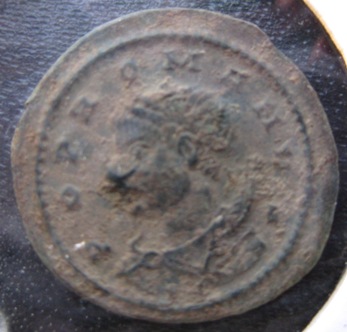
The front of an interesting coin.
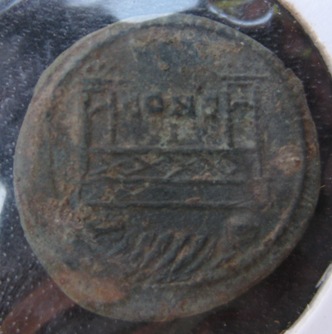
The back of the same coin.
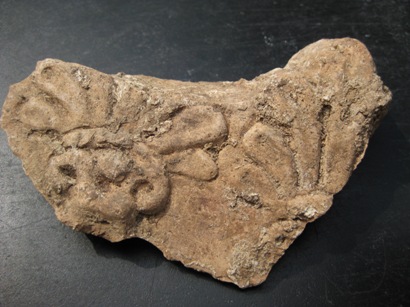
Decorative ceramic tile from the temple in the palaestra.
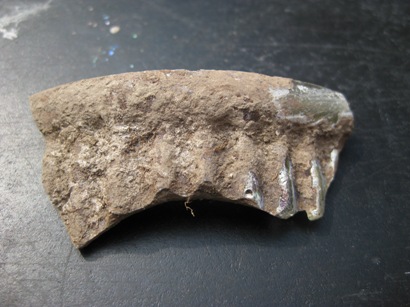
A glass rim edge with decoration. The glass has a corrosive coating on it from age.
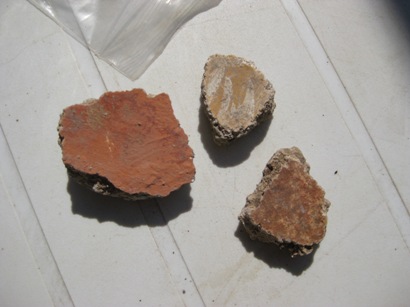
We have found a lot of painted plaster in various colours, such as plum, red, orange, and yellow.

A ring for a small finger.
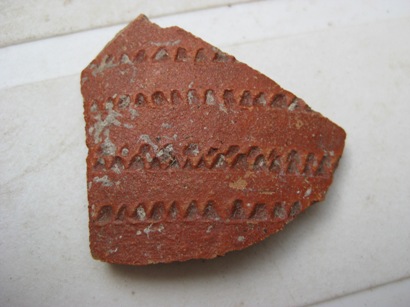
A decorated pot sherd.
———————————-
2008 Excavation
Slate tablet fragment
A very strong contender for ‘find of the dig’, this amazing piece turned up in finds washing yesterday. What was originally thought to be just part of the modern fill, turned out to be something very special indeed. Upon holding the slate up to the light, Greek letters became visible and everyone got very excited – perhaps we had discovered a late Roman school board.
Marble
So far, the facade of the forum has yielded some impressive marble. Most striking is a piece of what is believed to be serpentine marble from Greece. When wet, this marble shines a beautiful deep green as shown in the photo below. A spolia and surface archaeolgy survey of the adjacent baths has revealed that the baths too contain this type of marble. Perhaps the forum robbed marble from the baths in order to decorate it, or what is perhaps more likely is that there was a third building from which both the baths and forum benefitted.
Glass rim
A glass rim from a goblet was discovered near the cistern. Unfortunately it was broken by mattocking but repair will be no trouble. It has so far impressed many toursits because of its delicate and skillful construction. It is likely to be common tableware, simply decorated. We hope to have it examined more closely by an expert in order to tell us more. Many other fragments of glass are also turning up, perhaps revelaing a glass merchant resided in the forum.
Key
An almost complete key measuring about 3 inches in length has been found. Although simple in construction it is a nice example.
Coin/tag?
An unusual metal disc was unearthed several days ago. Around the same size as a nummi, this disc differs in that it has very clear markings on it in the shape of a cross. Whether this is a decorated nummi or some kind of simple ornament is unclear and warrants further investigation and opinion. Please get in touch if you have any ideas.
Coloured tesserai
These tesserai were found on the facade. One is turquoise and the others are possibly lapis lazuli. We are very lucky to have found these, as after late antiquity the vast majority of semi-precious tesserai were robbed from their original locations in order to decorate churches and other ecclesiastical buildings. Therefore we have just a few remaining pieces that must have been missed or dropped by those robbing them, possibly alluding to a richly decorated forum mosaic.
Jewelrey Fragment?
This unusual piece of metal turned up yesterday near to the cistern. Around 8mm in length, although it looks like a miniature chess piece, it is in fact believed to be a fragment of jewelrey, possibly from a crossbow brooch.
Diagnostic coin
This coin was found, like many of our really great finds, by the cistern. Although certainly not late antique, cleaning will reveal a very well preserved coin that can be easily identified. Letters and inscriptions on both the obverse and reverse are semi-visible already.
Richard Sadler 18/09/2008
Small Finds from Cleaning
The initial devegetation and cleaning of the forum is already producing some very promising small finds. Although some are not from the late antique layer, they are still worth mentioning as points of interest.
Nummus
The first coin of the dig is a nummus. It was discovered whilst trowel cleaning an interesting feature near to the baths which appears to be an apse, previously belonging to the baths. The coin, a nummus, is very small, no more than 11 or 12mm across, is made from bronze and dates to around the 4th century. There is no apparent inscription or decoration on either the obverse or reverse as of yet, and there probably will not be as they were of a very simple design, but cleaning may prove otherwise.

Die
During preliminary trowel cleaning of the south edge of the forum closest to the bath building on day 3, a very impressive die was unearthed. It is a complete specimen with ring and dot decoration, each face being visible and relatively undamaged.

Game Pieces
As well as the die, we have also found very nice game pieces. Several small ones have been found in various places during day 1. The material from which they are made is indiscernible at the moment, but it is very light and somewhat porous.
Day 4 has also produced some much larger pieces, possibly fashioned out of old pots as they are of ceramic type and very large and thick compared to the marble ones. We are very sure Luke is hoping to find an inscribed game board on the paving on which to use both the die and these pieces!

Decorated Pottery
A small number of decorated pottery fragments, possibly Samian ware, have also been cropping up. Most have been very small and non-diagnostic so far, but some nicely decorated pieces have been discovered on day 4 which probably warrant further investigation.

Inscription
During the early hours of day 4, a marble fragment bearing part of an inscription was discovered. Opinions vary concerning its original function, some think it may have been from a grave that fell out of use from the city’s necropolis, others think it may have formed part of some sort of secular decree, list of permissions or other public notice. Whatever the exact function may have been, it is still an impressive and beautiful find, dating to the 2nd century A.D.
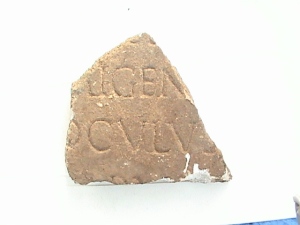
Richard Sadler 08/09/2008













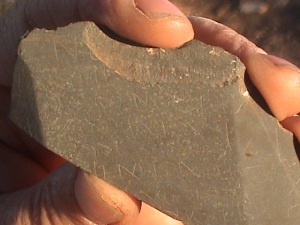







[…] Gering and Luke Lavan have just opened up access to the Finds section of their Berlin-Kent Ostia Excavations blog, where they are providing a chronicle of their […]
By: Current Epigraphy » An epigraphic fragment from the Foro della Statua Eroica at Ostia on September 12, 2008
at 6:18 pm
Is the die equal on all faces, or is it biased towards throwing sixes as many Roman dice are?
Keep up the good work,
all the best to everyone
Ellen
By: Ellen Swift on September 15, 2008
at 11:24 am
Hey Ellen thanks for the comment – we haven’t tried rolling the die is there anything we can look out for other than the obvious?
By: Angela Gillen on September 15, 2008
at 9:07 pm
like the dice , my question is with ellen , does the dice opposit faces equal 7 , ie 2+5 6+1 4+3 – we have found similar in kent ( uk ) – the BM have told us that up to the ( middilish ) of 2 nd centry all dice were crude and random , after this date , gambling and dice was ( in a word ) standerdised hence opposite sides = 7 , good luck with the rest of dig , best wishes andy ( metal finds / det for kafs )
By: andy stephney kafs on September 17, 2008
at 3:07 pm
Hello all,
with regards to the dice, the opposite faces do in fact add up to seven, so we are probably looking at a post mid-2nd century one. However, we have yet to find a gameboard to test it on so we don’t know if it is loaded or not!
Richard Sadler
By: lukelavan on September 18, 2008
at 9:38 am
[…] Richard Sadler’s latest additions to the Finds page on the Berlin-Kent Ostia Excavations Blog (18 September 2008), we find a fragment of a slate […]
By: Current Epigraphy » A slate fragment with Greek exercises(?) from the Foro della Statua Eroica at Ostia on September 18, 2008
at 3:20 pm